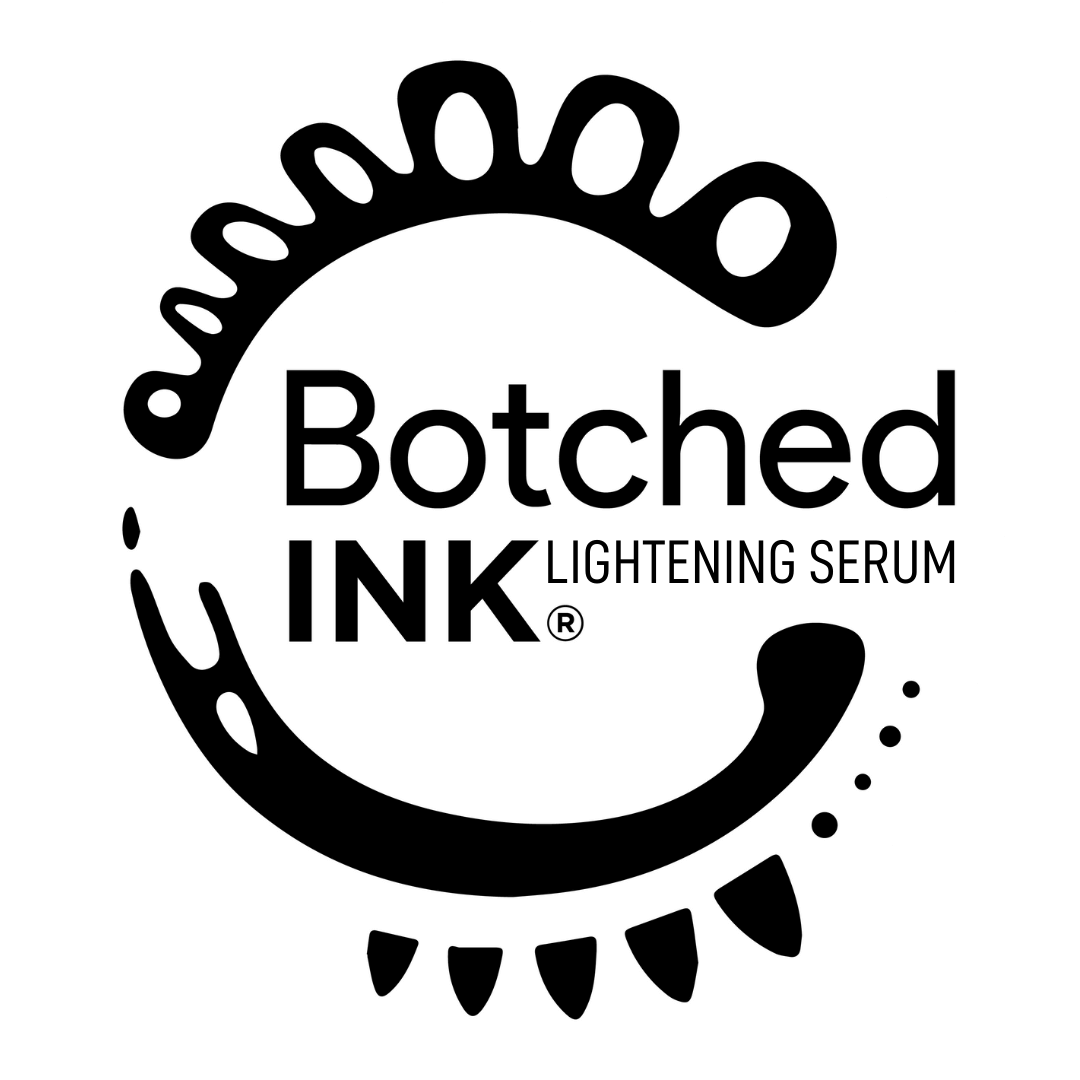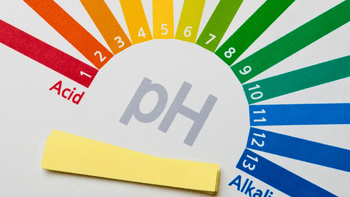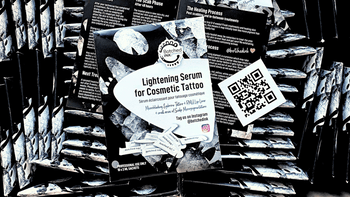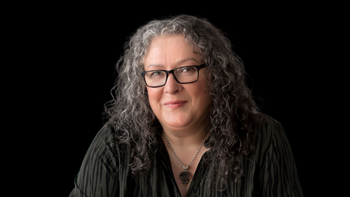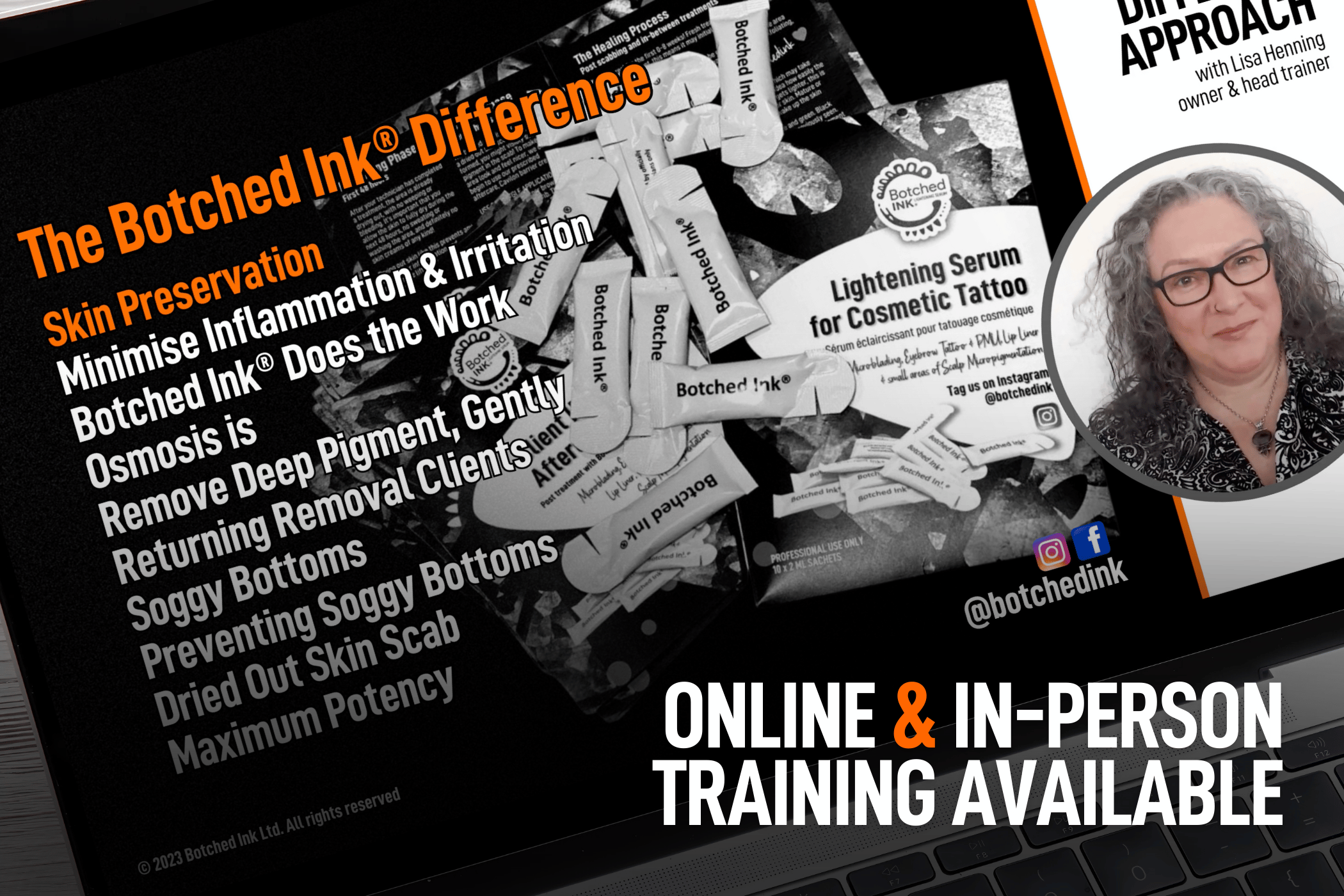Introduction
In this article, I’m explaining why some clients are left with yellow brows after laser eyebrow tattoo removal, and how Botched Ink® can fix them. It’s become a common issue across the PMU industry, but it’s not really a laser failure. It’s brown pigments that need understanding.
Laser removes the darkest tones first, black and red, revealing the yellow base that most brown pigments are built on. The result? Bright golden brows that don’t fade further because laser light can’t “see” yellow.
Botched Ink® works differently. It lifts all colours each session. Used first, it can prevent yellow brows altogether; if used after, it can also fix them. Either way, the client is likely to need a similar number of sessions.
Thanks for being here,
Lisa 🧡
TL;DR
Yellow brows after laser happen because laser removes dark pigments first, revealing the yellow base of most brown PMU pigments. Laser can’t target yellow, so it stays behind. Botched Ink® saline removal lifts all colours with consistent and effective treatments, flushing up pigment powders, and improving any scar tissue. The best results come from starting with saline first, then using laser later if any remaining black pigment is proving stubborn.
What is Saline Tattoo Removal? ➔
Find a Botched Ink® Tech Near You ➔
Why Yellow Brows Became So Common
Yellow brows didn’t start with bad laser work, they started when PMU artists who didn’t offer removal sent clients for laser, and laser techs who didn’t understand PMU pigments took over. Neither side meant harm, but both lacked the full picture.
Clients were left in the middle. Many didn’t want to return to a PMU artist, it felt like paying again for work that hadn’t gone right, so they went to laser clinics instead. The same problem repeated: good technicians, wrong knowledge, yellow brows.
Now the industry’s split. Some PMU artists have learned laser or saline removal but carried the same misunderstandings forward. Others, especially Botched Ink® techs, understand both sides, they know when saline alone can achieve the result and when to refer to a saline-friendly laser tech for deeper pigment.
This isn’t about blaming laser or saline. It’s about timing, pigment knowledge, and respect for how the two methods complement each other. When everyone understands the science and sequence, yellow brows stop being a surprise and start being preventable.

Brown Isn’t a Colour, It’s a Blend
There’s no such thing as a brown tattoo pigment. Every brow shade is a blend of black, red, yellow, orange, white ⚫🔴🟡⚪ and sometimes green or orange modifiers 🟠🟢. Each manufacturer uses different ratios to create warm, cool, or neutral tones.
Over years of touch-ups and colour corrections, clients can end up with multiple pigment layers from different brands, each reacting differently to laser. What looks like simple “brown brows” is really a layered cocktail of tones, and that’s why the laser’s job is never straightforward.
Microblading Removal with Botched Ink® ➔
Permanent Makeup Removal: Pigments ➔
Knowledge Gaps and Collaboration
Most laser technicians are trained in light and energy, not PMU pigment science. They see dark brows and assume black pigment, unaware that every brown is built on a yellow base. PMU artists, meanwhile, often know pigment chemistry but not laser behaviour.
When they work separately, clients get inconsistent results. When they work together, saline for surface colour, laser for deep black, outcomes are faster, safer, and far more predictable.
That’s why Botched Ink® promotes collaboration, not competition. The goal isn’t to replace laser; it’s to work in sequence so both methods perform at their best.

Patch Testing & Pigment Understanding
Why Patch Tests Matter
A proper laser patch test does far more than check skin reaction, it reveals the hidden pigments beneath the surface. When tested correctly, it shows what colours are waiting underneath the brown: red, orange, yellow, or even green. This helps determine whether laser alone can finish the job, or whether Botched Ink® should start first.
The Common Mistake
Too many laser techs perform the patch test and then go straight into full-brow removal the same day. That means they never see the true colour change that appears after a few days, once the skin redness has settled. The black might look gone at first, but the next layer, red, orange, or yellow, hasn’t had time to reveal itself. That’s how clients end up with yellow brows after multiple laser sessions, simply because the process was rushed.
A patch test doesn’t need to heal fully, but it does need a few days of observation. Once the surface settles, you can clearly see what colours are sitting underneath and plan accordingly.

How Botched Ink® Techs Use Patch Tests
Botched Ink® technicians use the patch test as a guide, not a green light. When a client comes to us after a laser patch test, we review which pigment colours have revealed and how the skin responded. If the patch shows yellow or red pigment, it’s time for Botched Ink® saline removal to lift those colours before laser continues.
Once saline has lightened the area, the client can safely return to laser later if any deeper black pigment remains. The patch test result becomes part of the treatment timeline, showing when to switch between methods, not just whether to proceed.
This combined approach protects the skin, saves time, and prevents the emotional toll of bright yellow brows in the mirror. It’s not about competing methods; it’s about sequencing them intelligently so each supports the next.
The Takeaway
Patch tests aren’t just about skin safety, they’re a map of what’s coming next. Reading them correctly separates trained operators from true professionals. A good technician doesn’t rush to treat; they read, plan, and adjust, giving every client results that heal beautifully, not regretfully.

Botched Ink® Can Fix Yellow Brows After Laser Removal
When Laser Leaves a Stubborn Yellow Tint
Many clients come to us after several rounds of laser, sometimes six, eight, or more sessions, only to find their brows still look warm, golden, or even neon yellow. This isn’t failure; it’s physics. The laser removed the black and red tones first, but yellow pigment sits deeper and reflects the laser light instead of absorbing it.
Botched Ink® can lift this pigment where laser can’t reach.
How Botched Ink® Works After Laser
Laser often compacts pigment deeper into the skin and creates microscopic scar tissue, that’s why some brows look “stained” even after full laser courses. Botched Ink® loosens and draws out that pigment through controlled osmosis, while its high aloe content supports gentle healing.
When pigment is trapped in scar tissue, our serum soaks deeper, reactivating that area and allowing pigment to move again. Two to three sessions are usually enough to restart the removal process and restore a natural tone.

What Makes Botched Ink® Different
Botched Ink® isn’t a generic saline soak or abrasive scrub. It’s a precision method: gentle needling to stir pigment, quick drying to catch the released colour, and ingredients designed to calm and protect the skin. Clients often expect pain, and are surprised when it’s comfortable.
Because it dries fast, the skin heals cleanly with thin, controlled scabs instead of thick, oozing ones. Less inflammation means faster recovery and healthier skin for future treatments.
Why Combination Treatments Work Best
After Botched Ink® has lightened or released the warm tones, laser can safely target any remaining deep black. It’s the reverse order that matters: start with saline when sunset colours appear, finish with laser only if needed.
This combination approach gives better clearance, fewer total sessions, and less trauma to the skin.
The Takeaway
Laser alone can’t remove every pigment colour but with Botched Ink®, clients finally have a gentle, effective fix for yellow or orange brows. Whether it’s a standalone treatment or part of a combined removal plan, it’s the smarter, skin-safe solution.

Preventing Yellow Brows with Knowledge & Combination Planning
Start Smart, Don’t Repair Later
The easiest way to prevent yellow brows after laser is to start with saline removal first. If a laser patch test reveals red, orange, or yellow pigment, that’s your early warning. Botched Ink® can lift those colours cleanly before laser even touches the skin. Once the sunset shades are gone, laser can safely target any remaining black pigment later if needed.
That simple change in sequence often decides whether a client’s journey is smooth and predictable, or months of frustration correcting what could have been avoided.
Takeaway: Prevention is always easier than repair. Start with saline, finish with laser only if it’s still needed.
Why Collaboration Matters
Laser technicians know energy and settings. PMU artists understand pigment chemistry. Both hold half the knowledge needed for safe, complete removal. When they work together, saline for surface layers, laser for deep black, results come faster, safer, and with healthier skin.
That’s why Botched Ink® promotes collaboration, not competition. We train techs to recognise when saline alone is enough, and when a combination is smarter.

When to Use Combination Treatments, and When to Stop
Knowing When Enough Is Enough
Just because pigment is still visible doesn’t mean it’s ready for more treatment.
Both laser and saline create controlled trauma, and the skin needs time to process what’s already happened. Pushing too soon, or switching methods too quickly, risks inflammation, texture changes, and pigment being driven deeper into the skin.
With Botched Ink®, we prioritise recovery before action. Each session builds on the last, but only when the skin shows it’s ready. That’s why results improve over time — not because we’re working harder, but because we’re respecting the skin.
When Combination Treatments Work Best
Combination removal works beautifully when each method does its own job:
Botched Ink® first: Lifts and clears lighter or stubborn pigments, yellows, reds, oranges, while softening any scar tissue.
Laser later: Targets deeper black pigment that saline can’t reach.
Used in sequence, saline prepares the skin and clears the colours laser can’t “see.” Laser then becomes more effective, needing fewer passes and causing less irritation. This approach doesn’t replace laser, it refines it.

When to Stop and Let the Skin Recover
If pigment stops lifting after several sessions, it’s time to pause. Overworking healed skin won’t force better results; it only hardens scar tissue and traps pigment underneath. That’s when clients think removal has “stalled,” when in reality, the skin just needs time to reset.
Botched Ink® techs are trained to read the skin, not the calendar. Sometimes the smartest move is rest, a few months for the skin to normalise before continuing.
Why This Matters for Clients and Techs
True results come from understanding that removal is a process, not a race. The goal isn’t only to clear pigment, it’s to preserve the skin so future pigment heals and holds evenly. That’s what separates fast fixes from professional, lasting results.
The Takeaway
Laser and saline aren’t rivals; they’re tools. Knowing which to use, and when to stop, defines a professional. With Botched Ink®, removal becomes measured, predictable, and skin-safe at every stage.

Chemical Tattoo Removal
Why Chemical Tattoo Removal Still Gets Used
After laser leaves stubborn yellow or orange tones, some clients are persuaded to try chemical tattoo removal, usually glycolic, lactic, or alkaline solutions. They sound reassuringly clinical, but these products were designed for superficial facial peels, not tattoo removal.
When you tattoo a chemical peel into the skin, the concentration and penetration go far deeper than skincare. What was once a controlled exfoliation becomes a deep wound.
Superficial vs Deep Pigment: Where It Seems to Work
On the surface, chemical removers can appear effective. If pigment sits close to the epidermis, a few sessions may visibly lighten colour. But that’s only part of the story.
Most brows hold multiple layers of pigment from top-ups, corrections, and old work — and those deeper layers don’t move. They’re often compacted, especially after laser has shattered and dispersed pigment into the dermis.
So while the surface may look lighter, deeper pigment becomes more stubborn, sometimes sealed in by scar tissue from combined laser and acid trauma.

The Real Cost: Skin Barrier Damage
Each chemical tattoo removal session creates a controlled injury that depends on thick scabbing to release pigment. When repeated or done too deeply, it damages the skin barrier, leaving long-term texture changes, redness, or hypopigmentation.
Instead of dissolving sugar cubes by stirring, we are tattooing in a solution to remove those sugar cubes. That solution needs to be kind to the skin!
After laser, the skin has already endured trauma. Adding chemical solutions risks over-processing, delayed healing, and unpredictable colour retention.
The Safer Alternative: Saline That Works With Skin
Botched Ink® is designed for exactly this situation, pigment that’s deep, trapped, or chemically altered. Our saline serum draws pigment out gently through osmosis, not destruction. It rehydrates damaged tissue, loosens compacted pigment, and encourages natural healing. Instead of burning the skin, it restores its ability to repair itself.
The Takeaway
Chemical removers may lighten surface pigment, but they don’t solve the deeper problem, pigment trapped below or sealed by scar tissue. Botched Ink® treats both safely, giving visible lightening and restoring long-term skin health.

Laser Yellow Brows FAQs
How to remove yellow eyebrows after laser?
Yellow brows after laser can be lifted safely using Botched Ink® saline tattoo removal. The saline solution gently draws out leftover pigment through controlled healing, improving tone without damaging the skin. A few sessions can fade yellow or orange hues left behind by laser.
Why do eyebrows turn yellow after laser tattoo removal?
Laser breaks down darker pigments first, such as black and red, revealing the lighter yellow base used in most brown PMU pigments. Laser light doesn’t “see” yellow well, so it remains visible after the dark tones fade, this is why some clients are left with bright yellow brows.
Can yellow pigment after laser brow tattoo removal be fixed?
Yes. Yellow pigment can be corrected with saline tattoo removal using Botched Ink®. The formula releases pigment from scar tissue and lifts it closer to the surface, allowing the yellow to fade over a few treatments. It’s a gentle, non-laser solution for colour correction.
Is saline removal effective on yellow brows left by laser?
Yes, especially when the laser can no longer target the pigment. Botched Ink® saline removal reactivates the treated area, loosening pigment trapped by scar tissue and helping it exit naturally during healing. This combination method is safe for all skin types and tones.
How many sessions does it take to remove yellow brows?
Most clients need 2–4 sessions of Botched Ink® saline removal to noticeably lift yellow or orange pigment left after laser. The exact number depends on pigment depth, saturation, and skin condition. Sessions are spaced 8–12 weeks apart for full healing between treatments.
When should you switch from laser to saline removal?
Switch to saline removal when laser results plateau or yellow, orange, or green tones appear. At this stage, laser light can’t target the remaining colours effectively. Botched Ink® can safely continue the process by lifting the remaining pigment without additional trauma.
Conclusion
Yellow brows after laser aren’t a failure, they’re a sign that something deeper wasn’t understood. Most laser technicians simply weren’t trained in the colour science of PMU pigments. When the darker tones lift first, the yellow and orange bases underneath become visible, and laser can’t see them to remove.
That’s where Botched Ink® changes everything. Our saline solution doesn’t rely on pigment colour; it lifts what laser leaves behind. By working with the skin, not against it, we can correct yellow, orange, or green tones while restoring a healthier surface for future treatments, or for the brows to fade naturally.
If you’re a client left with stubborn yellow brows, or a technician who wants to learn how to fix them, you don’t have to start over, you just need a better plan. Prevention starts with understanding, and healing begins with the right tools.
Botched Ink® isn’t here to compete with laser, we’re here to complete what laser started.
Laser Yellow Brows FAQs
How to remove yellow eyebrows after laser?
Yellow brows after laser can be lifted safely using Botched Ink® saline tattoo removal. The saline solution gently draws out leftover pigment through controlled healing, improving tone without damaging the skin. A few sessions can fade yellow or orange hues left behind by laser.
Why do eyebrows turn yellow after laser tattoo removal?
Laser breaks down darker pigments first, such as black and red, revealing the lighter yellow base used in most brown PMU pigments. Laser light doesn’t “see” yellow well, so it remains visible after the dark tones fade, this is why some clients are left with bright yellow brows.
Can yellow pigment after laser brow tattoo removal be fixed?
Yes. Yellow pigment can be corrected with saline tattoo removal using Botched Ink®. The formula releases pigment from scar tissue and lifts it closer to the surface, allowing the yellow to fade over a few treatments. It’s a gentle, non-laser solution for colour correction.
Is saline removal effective on yellow brows left by laser?
Yes, especially when the laser can no longer target the pigment. Botched Ink® saline removal reactivates the treated area, loosening pigment trapped by scar tissue and helping it exit naturally during healing. This combination method is safe for all skin types and tones.
How many sessions does it take to remove yellow brows?
Most clients need 2–4 sessions of Botched Ink® saline removal to noticeably lift yellow or orange pigment left after laser. Worth saying this would also likely to have been the same number before laser. Sessions are spaced 8–12 weeks apart for full healing between treatments.
When should you switch from laser to saline removal?
Switch to saline removal when laser results plateau or yellow, orange, or green tones appear. At this stage, laser light can’t target the remaining colours effectively. Botched Ink® can safely continue the process by lifting the remaining pigment without additional trauma.
Where to Go From Here
If you’ve read this far, you already know what sets Botched Ink® apart, gentle, effective saline tattoo removal designed for both results and skin health.
For clients: Ready to remove or lighten unwanted brows? Find a Botched Ink® technician near you. Our "Find a Tech Map" connects you with trained professionals worldwide.
Botched Ink® Techs Near You ➔
For professionals: Thinking of offering saline tattoo removal in your clinic? Enrol in our online training or in-person model class. You’ll learn the Botched Ink® method directly from the brand that created it.
Saline Tattoo Removal Training ➔
Botched Ink® is more than just a solution in a sachet, it’s a system built on education, support, and trust. Whether you’re a client or a tech, you’ll always have guidance every step of the way.
Thank you for reading!
Lisa Henning
Owner and developer of Botched Ink®
